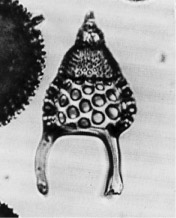 Thyrsocyrtis
(Pentalacorys) triacantha (Ehrenberg)
Thyrsocyrtis
(Pentalacorys) triacantha (Ehrenberg) Thyrsocyrtis
(Pentalacorys) triacantha (Ehrenberg)
Thyrsocyrtis
(Pentalacorys) triacantha (Ehrenberg)Podocyrtis triacantha Ehrenberg, 1873, p.254; 1875, pl.13, fig.4; Sanfilippo and Riedel, 1982, p.176, pl.1, figs.8-10, pl.3, figs.3-4 (with synonymy)
General form conical. Cephalis subspherical, with few small pores, bearing cylindrical horn several times its length. Collar stricture distinct. Thorax considerably shorter than abdomen, broadly conical or slightly inflated, with small subcircular pores. Lumbar stricture usually slight. Abdomen broadest segment, robust, with large subcircular pores, distinct peristome, and occasionally thorny surface. Three feet cylindrical, of variable length (often longer than abdomen), arising from peristome, curved with convexity outward, with terminations simple or ragged, rarely forked, and rarely bladed proximally (Sanfilippo and Riedel, 1982).
Based on 25 specimens. Length excluding horn 240-370 µm, of cephalothorax 65-85 µm, of abdomen 85-125 µm; maximum breadth 130-195 µm (Sanfilippo and Riedel, 1982).
T. triacantha differs from its ancestor T. tensa in the feet being convex outward, from T. tetracantha in having a differentiated peristome and constantly three feet, and from T. lochites in the feet originating from the peristome rather than slightly above it (Sanfilippo et al., 1985).
Cephalis with a variable cylindrical or elongate-conical horn. Thorax broadly conical to slightly inflated, decreasing in size in late forms (from 102 µm wide in early specimens to 83 in late forms, and in length from 80 µm to 62 µm). The thick-walled abdomen is broader than the thorax, occasionally thorny, with large subcircular pores (10-13 on a half-circumference in early forms and 5-7 on a half circumference in late forms). From a distinct peristome [originate] three cylindrical feet of variable length, (often longer than the abdomen), curved with the convexity outward, with terminations simple or ragged, rarely forked (Sanfilippo et al., 1985).
T. triacantha occurs commonly in tropical assemblages from middle middle through late Eocene. Its morphotypic last appearance lies within the Calocyclas bandyca Zone. Its evolutionary transition from Thyrsocyrtis tensa is approximately synchronous with the lower limit of the Thyrsocyrtis triacantha Zone.
This species evolved from T. tensa and into T. tetracantha. T. lochites is an evolutionary offshoot from this lineage.